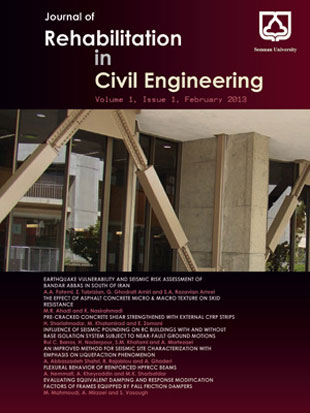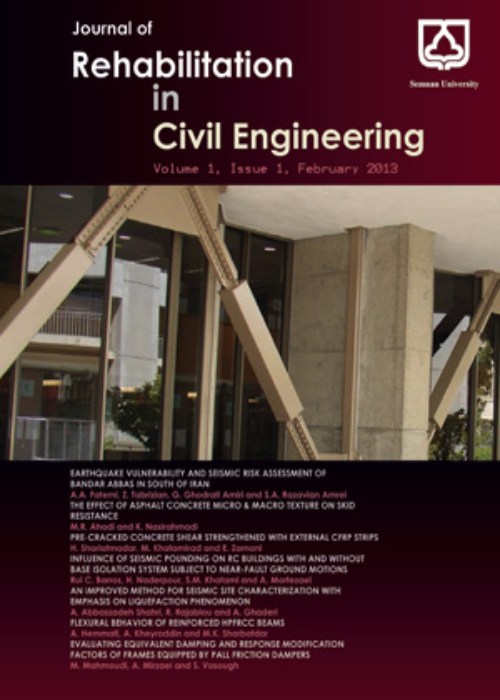فهرست مطالب

Journal of Rehabilitation in Civil Engineering
Volume:1 Issue: 1, Winter - Spring 2013
- تاریخ انتشار: 1392/01/20
- تعداد عناوین: 7
-
-
Pages 1-14Bandar Abbas (center of Hormozgan province) is the most important port city in the south of Iran because of its historical places, cultural, economic, social and political importance. High risk of earthquake occurrence in this city and its province indicates the necessity of surveying the seismic vulnerability of buildings. The object of this paper is collected from existing Buildings, compiled by aggregating data from sidewalk surveys and other observations. Estimated loss distributions and damage were mapped on area by area. Seismic hazard in the area was obtained using the seismic source zones for a probability level of 10 percent occurrence in 50 years. Finally value of vulnerability was mapped on seismic zones in each area. The older areas of the cities are expected to suffer the highest amount of damage and the highest seismic hazard occurs in these areas as well. We can realize the general vulnerability of the city.Keywords: Seismic risk assessment, Seismic vulnerability, Bandar Abbas, Iran
-
Pages 15-28Skid resistance and road condition are common indices of road safety; therefore providing adequate skidding resistance will reduce the incidence of road accidents. The surface macrotexture has a large effect on the characteristics of road surface skidding, which is the focus of this research. During the study, the mean texture depth of the road surface was measured, in order to determine the conditions that ensure the maximum contact area between the vehicle tires and road surface during wet conditions. The Pavement Guideline No. 234 was consulted for the test procedure and road surface composition, which used open and dense graded crushed lime aggregates with varying percentages of bitumen applied to the mix design. The samples were then tested to assess their stability using the Marshall and Gyratory Tests. The results showed that with the application and evaluation of the sand patch method, where the effect of the macrotexture on skidding resistance was analyzed with various gradations, there was an improved higher skidding resistance and a subsequent projected reduction of accidents with an increased safety.Keywords: Safety, Skid Resistance, Micro, Macro Texture, Sand Patch, British Pendulum Tester
-
Pages 29-38In reinforced concrete design, there are situations where transfer of shear across a specific plane needs to be considered. Examples of such situation include corbels, bearing shoes, ledger beam bearing, and a host of connection between precast concrete elements. In this study, the shear transfer behavior of reinforced concrete is investigated experimentally by conducting test on 6 precracked push-off specimens. The major parameters considered are the amount of reinforcement and externally bonded fiber reinforced polymer fabrics through the shear plane. External strengthening with Fiber Reinforced Polymer (FRP) fabrics is an effective technique for improving the structural performance and life span of the existing reinforced concrete structures. This paper illustrates the result of shear transfer capacity and modes of failure of the precracked reinforced concrete push-off specimens bonded externally with FRP. An experimental investigation was conducted to study the effectiveness of FRP as an external reinforcement. Based on experimental results, the external FRP reinforcement controls the shear slip along the shear plane and crack width. In the unstrengthened push-off specimens, the pre-existing crack along the shear plane will reduce the ultimate shear transfer capacity and increase of shear slip at all load levels. However in strengthened specimens, the external FRP reinforcement will control the increase of slip and increase the ultimate shear stress transfer capacity along the shear plane.Keywords: Shear friction, Push off, FRP, Pre, cracked
-
Pages 39-52Building pounding occurs between two adjacent buildings with small gap or without sufficient separation distance. It leads to damage buildings during earthquake due to impact. Many researchers have investigated building pounding based on impact force reduction and energy dissipation increase, when two buildings collide with each other. In numerical investigations, using specific link element, impact force is calculated in order to get the proper evaluation of damage for preventing failure of structural elements. In this paper, focusing on numerical investigation, the effectiveness of impact and energy dissipation is studied. For this challenge, two RC structural models are considered to evaluate the pounding to calculate the impact force and finally, to compare the effectiveness of Base Isolation (BI) support against fixed support. A link element is located at the connection level between two studied dynamic models.Keywords: Pounding, Fixed base, Base isolation, RC building, Collision, Mathematical formulation
-
Pages 53-65Iran is an active seismic region. Earthquake damage is commonly controlled by three interacting factors including source and path characteristics, local geological and geotechnical conditions and type of the structures. Obviously, all of this would require analysis and presentation of a large amount of geological, seismological and geotechnical data. In this paper, nonlinear geotechnical seismic hazard analysis considering the local site effects was executed and the soil liquefaction potential analysis has been evaluated for the Nemat Abad earth dam in Hamedan province of Iran because of its important socioeconomic interest and its location. Liquefaction susceptibility mapping is carried out using a decisional flowchart for evaluation of earthquake-induced effects, based on available data such as geological, groundwater depth, seismotectonic, sedimentary features, insitu, field and laboratory geotechnical parameters. A series model tests were conducted and then based on the achieved data the idealized soil profile constructed. A C# GUI computer code “NLGSS_Shahri” was developed and then employed to evaluate the variation of shear modulus and damping ratio with shear strain amplitude to assess their effects on site response. To verify and validate the methodology, the obtained results of the generated code were compared to several known applicable procedures. It showed that computed output of this code has good and suitable agreement with other known applicable procedures.Keywords: Nemat Abad earth dam, “NLGSS, Shahri”, GUI computer code, Earthquake record
-
Pages 66-77High Performance Fiber Reinforced Cementitious Composite (HPFRCC) materials exhibit strain hardening behavior with multiple cracking under tensile loading. In this paper, experimental and parametric studies are performed to assess the influence of using HPFRCC material instead of normal concrete in reinforced concrete beams. After calibrating the experimental results, the analytical results including ductility and plastic hinge characteristics for simply supported beams with different values of compressive strengths are presented and compared with each other and also with the experimental data, where available. The analytical and experimental results indicate that using HPFRCC material instead of normal concrete in RC beams concluded to an increase in ultimate load, deflection, ductility ratio, plastic hinge length and rotation capacity compared to RC beams. In RH beam, fibers act as extra steel reinforcements and high ductility of this beam is attained by existence of this fibers and bridging mechanism of them which prevent the crushing of compressive HPFRCC material.Keywords: Finite Element, Plastic Hinge, Reinforced Concrete, Rotation Capacity
-
Pages 78-92A study on the evaluating equivalent damping and response modification factors of frames equipped by Pall Friction Dampers is presented. To do so, buildings with various stories were considered. Nonlinear and linear dynamic time history analysis has been performed to evaluate equivalent damping for Pall Friction Dampers. Ground motions with various frequency characteristics scaled with Iranian earthquake resistant design code. In addition, nonlinear incremental dynamic analysis has been performed to evaluate the response modification factors. In this article, equivalent damping and seismic response modification factor for moment resisting frames with and without Pall Friction Dampers have been determined separately. The governing parameters were identified and their influence was traced and summarized along with implications for practical design. The results show that the equivalent damping of these frames using damper is higher than frames without it. Also we have this result for the response modification factors. It was also found that the number of stories have a great effect on these two characteristics of the buildings.Keywords: equivalent damping, response modification factors, Pall Friction Dampers


